General Information - 1
The Agilent MCCD measures the dc cell resistance by first disconnecting the charge/discharge circuits from all cells. A pulse generator in the Agilent MCCD mainframe is connected sequentially to each cell. The pulse generator passes a
Probe Resistance
Probe resistance measurements can also be performed. The Agilent MCCD uses the remote sense to measure the resistance of both the power and sense probes. Probe resistance measurements can be made on command when a sequence is not running.
The measured probe resistance is the total resistance in the signal path, which includes wiring resistance, probe resistance, and the resistance of any connectors in the signal path. For the sense probe measurement, the resistance measurement includes the internal scanner resistance, which is typically 1000 ohms. The power and sense probe measurements return the actual measured value in ohms.
In addition to the
Data Logging
During a charge/discharge sequence, the Agilent MCCD is constantly making voltage, current, and capacity measurements. Instead of logging each and every measurement into a data buffer, the data logging can be controlled so that only critical measurements are logged to the data buffer. This is called
The following events can be used to trigger critical measurements:
Change in voltage If the trigger is ΔV, a data log record will be written to the buffer when a user-
(ΔV)specified voltage change is exceeded. If ΔV is set to 100 mV, then each time the voltage reading changes by more than 100 mV, a record is written to the buffer.
Change in current (ΔI)
Change in time (Δt)
If the trigger is ΔI, a data log record will be written to the buffer when a user- specified current change is exceeded. If ΔI is set to 100 mA, then each time the current reading changes by more than 100 mA a record is written to the buffer.
If the trigger is Δt, a data log record will be written to the buffer when a user- specified time interval is exceeded. If Δt is set to 1 second, then every second a record is written to the buffer. Δt is effectively a
The acceptable range of values for ΔV, ΔI and Δt are 0 to infinity. Setting the value to 0 or near 0 will cause all readings to be logged in the buffer, because every reading will exceed the ΔV, ΔI or Δt value of zero. This will fill up the measurement log very quickly. Setting the value to a high number or to infinity will cause no readings to be logged in the buffer because no reading will exceed the ΔV, ΔI or Δt value.
17
